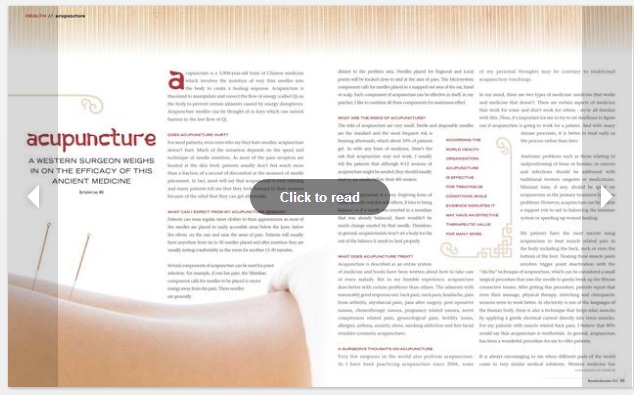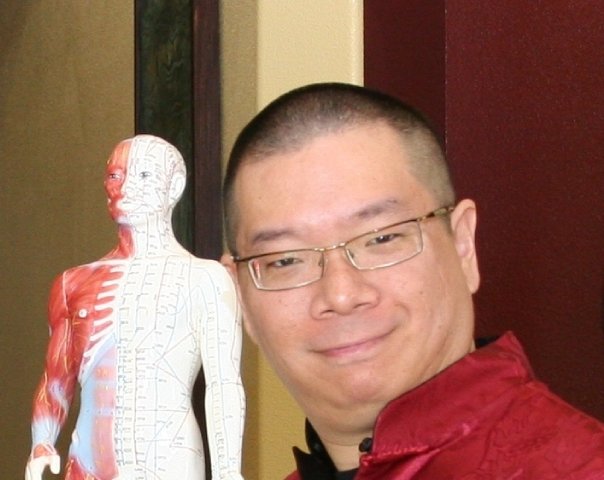Dr. Calvin Lee's recent article
about
Acupuncture
Link for
November/December 2012 (Inaugural) issue of Contentment Health

You could either read the magazine
article above, or the original text which is shown below.
Below is the original text of the article
ACUPUNCTURE
Calvin Lee, MD
What is Acupuncture
Acupuncture is a form of Chinese medicine, originating about 5000
years ago, which involves the insertion of very thin needles into
the body to create a healing response. There are theories regarding
manipulation of the flow of energy as the main acupuncture mechanism
of action. This energy is called Qi (sometimes spelled Chi).
Disruption in the flow of energy is believed to be responsible for
ailments. According to acupuncture theory, Qi flows through 12 main
meridians associated with solid and hollow organs. The solid organs
are considered Yin and the hollow organs are consider Yang forms of
energy. The balance of Yin and Yang is integral to the theory of
acupuncture. There are 8 other meridians that are also involved
which do not involve organ systems. Acupucture needles can be
thought of as keys which can unlock barriers to the free flow of qi.
Acupuncture points, which can be considered the "locks", are
found along these meridians and in the ear, hand, and scalp. These
areas are called microsystems where the entire body is represented
as a map. This is much like in the brain where there are certain
sections mapped to assist the body with sensation and motor activity
in predictable locations. In western neuroscience this is called a
"homunculus." Meridian and microsystem acupuncture points are often
correlated with areas of lowered electrical resistance when using
measuring devices. These acupuncture points can also be areas of
slight tenderness. There are about 2000 specific acupuncture points
described.
Does acupuncture hurt?
For most patients, even ones who say they hate needles,
acupuncture doesn't hurt. Most will say the opposite, that
acupuncture is very relaxing. If there is any discomfort, it is at
the moment of needle placement which is a fraction of a second, and
much of the sensation depends on speed and technique of needle
insertion. There is a form of acupuncture known as "Ah-Shi" which
may be slightly more uncomfortable. This style is most
surgical-like in which the needle is used to lightly break up
knotted connective tissue - such as the ones we find on our back
muscles. Even with the slight discomfort - it only lasts a few
seconds. Many patients tell me that they look forward to their
sessions because of the relief that they can get afterwards.
Furthermore, during the acupuncture needle insertion, patients are
usually talking to me the whole time.
There are different styles of acupuncture with different opinions
on depth of needle insertion. The Japanese style in general is more
superficial than the Chinese style. Patients usually don't feel
much difference between the styles since most of the pain receptors
are located at the skin level.
The acupuncture session
Most of the needles are placed in easily accessible areas below
the knee, below the elbow, on the ears, and near the areas of pain.
One can wear regular street clothes. Several components of
acupuncture can be used for point selection. For example, if one
has pain, the meridian component of acupuncture places needles to
move energy away from the pain and these needles are distant to the
problem area. Then there are needles placed in the regional and
local points which are located close to and at the area of pain.
Then there is the microsystem component where acupunture needles are
placed in a mapped out area of the ear (or hand or scalp). Each
component of acupuncture can be effective in itself. In my
practice, I like to combine all three components of Meridian,
Local/Regional, and microsystem acupuncture. Patients will usually
have anywhere from 6 to 30 needles placed. After insertion of the
needles, the patients are usually resting comfortably in the room
for another 15-30 minutes. Patients usually come for 4-16 sessions
of acupuncture to get maximal resolution of their problems. The
acupuncture sessions can be spaced as close as every day to as far
as once a month. Most of my patients come once to twice per week.
Much of the frequency of visits also depends on the presenting
problems.
What are the risks of acupuncture?
The risks of acupuncture are very small. Sterile and disposable
needles are the standard. The most frequent risk is bruising
afterwards. I think about 10% of the patients get a bruise. If
patients are pregnant, acupuncturists usually pick slightly
different points to use because some points have the side effect of
uterine contraction. As with any form of medicine, there's the risk
that acupuncture may not work. I usually tell the patients that
although 8-12 sessions of acupuncture might be needed, we should
usually start to see results before the 4th session of acupuncture.
Overall, acupuncture is a very forgiving form of medicine with very
few side effects. It tries to bring balance. Thus if a needle was
inserted in a meridian that was already balanced, there wouldn't be
much change exerted by that needle. Therefore, in general,
acupuncturists wouldn't set a body too far off center. Balance is
what the body needs to heal properly.
What does acupuncture treat?
Acupuncture has been described to be an entire system of
medicine. Books have been written about how to take care of every
malady. In my humble experience, acupuncture does better with
certain problems than others. The ailments with reasonably good
responses are: back pain, neck pain, headache, pain from arthritis,
myofascial pain, pain after surgery, post operative nausea,
chemotherapy nausea, pregnancy related nausea, nerve compression
related pain, gynecological pain, fertility issues, allergies,
asthma, anxiety, stress, smoking addiction, and fine facial wrinkles
(cosmetic acupuncture).
My views on acupuncture as a surgeon
This section is based on my own personal thoughts on acupuncture
which I have been practicing since 2006. Currently, there are very
few surgeons in the world who also perform acupuncture. My views
here are may be contrary to traditional acupuncture teachings.
In my mind, there's two types of medicine - medicine that works
and medicine that doesn't. There's certain aspects of medicine that
works for some and doesn't work for others - we're all familiar with
this. Thus, it's important for me to try to set deadlines to figure
out if acupuncture is going to work for a patient. And with many
disease processes, it is better to treat early in the process rather
than later.
Anatomic problems such as those relating to malpositioning of
bone or hernias should be addressed with traditional western
surgeries. Cancer and infections also fall into the category of
anatomical problems which should be removed whenever possible with
surgery and medications, and minimal time if any should be spent on
acupuncture as the primary treatment for these problems. Here,
acupuncture can play a supportive/complimentary role - such as
balancing the immune system or speeding up wound healing.
The top procedure that works for my patients using acupuncture is
muscle related pain anywhere in the body - such as the back, neck,
or even the bottom of the foot. The procedure involved in treating
some of these muscle pains involves trigger point deactivation with
the "Ah-Shi" technique of acupuncture which can be considered a
small surgical procedure that uses the needle to gently break up the
fibrous connective tissues. Patients are sometimes sore in the
recovery phase of this procedure which usually lasts less than 24
hours - very similar to muscle soreness after an intense workout.
After getting this procedure, patients report that even their
massage, physical therapy, stretching and chiropractic sessions seem
to work even better. As electricity is one of the languages of the
human body, there is also a technique which applies a gentle
electrical current directly into the tense muscle which can help
them relax.
It is always encouraging to me when different parts of the world
come to very similar medical solutions. Western medicine has come
up with methods similar to acupuncture. The closest equivalent to
"Ah-Shi" would be called "dry-needling." And the closest equivalent
to adding electrical currents to the needles would be a western TENS
(Transcutaneous Electrical Nerve Stimulation) unit which is applied
as patches on top of the skin. As for cosmetic acupuncture, western
medicine has independently created something similar a few years
ago. It involves a small roller which has attached needle spikes
coming out which automatically pierces the skin which results in
more collagen production. Cosmetic acupuncture requires specific
placement of needles under the fine wrinkles of the face. This
technique was thought of thousands of years ago. Although it is
much more tedious, I think it is superior to the current plastic
surgical rollers because of the improved accuracy of manual
placement and the ability to leave the needles in place to create
even more of a collagen building response.
For my patients with muscle related back pain, I believe that 80%
would say that acupuncture is worthwhile. In general, acupuncture
has been a wonderful procedure for me to offer patients especially
with the chance to cure problems with minimal side effects.
About Dr. Calvin Lee:
Dr. Calvin Lee has a degree in neuroscience
from Brown University and is a
board certified general surgeon who practices
acupuncture in
Modesto, CA. With his plastic surgeon wife, Dr. Tammy Wu, he
also practices other needle related surgical procedures: Botox,
filler, and vein injections. He received his initial acupuncture
training through a program offered to western trained medical
doctors at Stanford University
and has had additional training in Berkeley and
Taipei, Taiwan.
Dr. Calvin Lee's office is Surgical Artistry, 2336 Sylvan Ave. Suite
C, Modesto, CA 95355. (209) 551-1888.
www.surgerytoday.com |



Date of edit:
02/24/2013